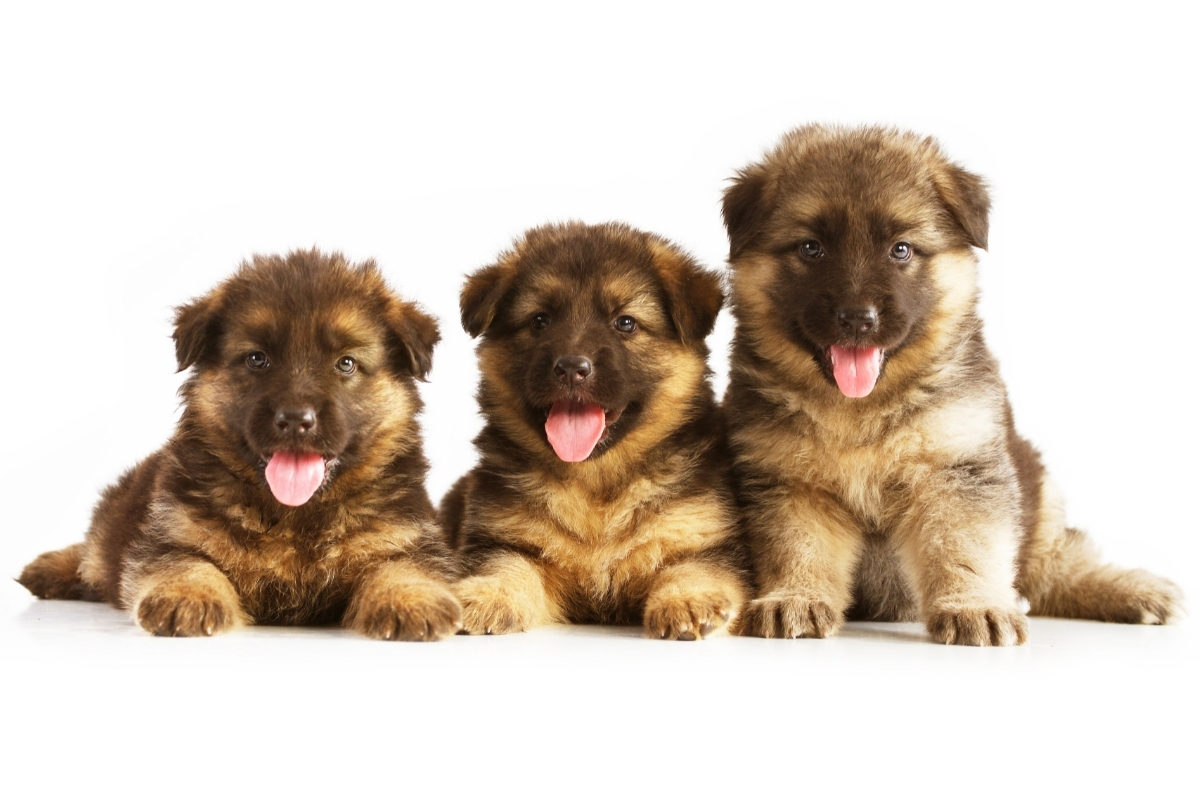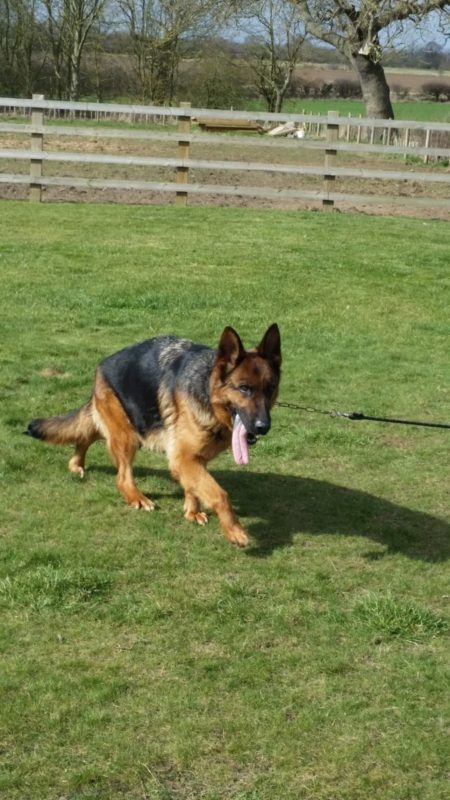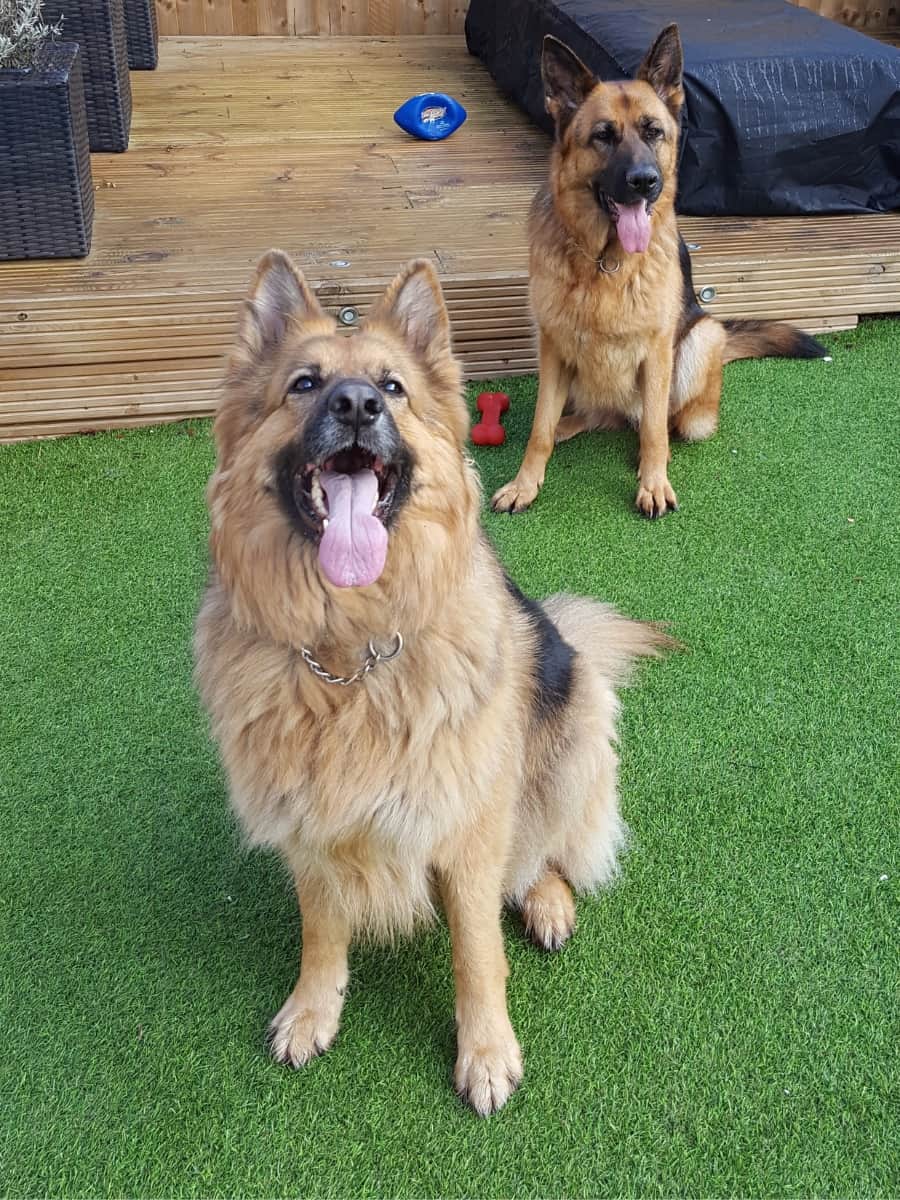“When do German Shepherds stop growing?” is a crucial question to consider early on if you’re planning to bring a German Shepherd puppy into your home.
Understanding the growth trajectory of these dogs is essential, as it influences various aspects of their care.
Alongside their feeding habits and activity levels, one of the most important factors to be aware of is their eventual size and the age at which they reach full maturity.
German Shepherds typically stop growing when they reach 18 to 24 months old. However, their physical development can continue for up to 36 months. During this period, they reach their full height and weight, with males generally being larger than females. Proper nutrition and exercise are crucial for their healthy growth.
In this article, we’ll explore the growth stages of German Shepherds, featuring height and weight charts for both males and females.
We’ll examine how genetics, nutrition, and exercise impact their development and provide tips for maintaining their health and well-being during these crucial early years.
Expect insights into the physical and behavioral changes as your German Shepherd matures.

When Do German Shepherds Stop Growing?
Have you ever wondered when your energetic German Shepherd will reach its full size?
Knowing when your German Shepherd stops growing helps in providing appropriate care, ensuring their physical and mental well-being, and making informed decisions about their health and lifestyle needs.
As you continue to our next section, you’ll discover a comprehensive guide that visually tracks the growth milestones of your furry companion, ensuring you’re well-equipped to support their journey to adulthood.
Growth Chart
It is well known that the time it takes for a growing puppy to reach adult body weight varies greatly, with larger breeds taking longer than smaller breeds.
However, this study also indicated that additional growth patterns exist in breeds of similar size. For this reason, we will look at a growth chart specifically for the German Shepherd.
A German Shepherd’s growth chart tracks height and weight across time and serves two purposes.
The first goal of such a chart is to set expectations. If you’re looking to get yourself a German Shepherd puppy, you might hesitate because you’re unsure how big he will grow. By referring to a growth chart, you’ll know what to expect.
The other, less-used purpose of a growth chart is to set the norm against which the dog’s growth is measured. By looking at the growth charts below, you can make sure your male or female GSD is growing at a healthy pace.
However, a word of caution…
The German Shepherd growth charts below (weight and height) are only approximate guidelines. Don’t stress if these figures are not precisely the same as your pup’s growth, as they are only estimations.
For example, my GSD girl is very tall, standing 27 inches, and she weighs a whopping 88 lbs (40kg).
Nonetheless, she was (and still is) proportionate to her size and was never under or overweight as she developed. But there’s no way she exactly matched the figures in the German Shepherd growth chart.

Here, it’s important to point out the consequences of improper feeding in large breeds, particularly during the vulnerable growth phase.
Due to the rapid growth of large breeds, it’s crucial to feed nutrients in their correct proportions, as getting this wrong can result in even faster growth due to excess energy. This can lead to joint diseases such as canine hip dysplasia and osteoarthritis, along with other health issues.
In a nutshell, large breeds such as the German Shepherd need a higher quantity of protein and lower amounts of calcium, phosphorus, and fat. Learn more about feeding your GSD large breed food here.
No two puppy growth spurts are the same, but if you are ever concerned about your German Shepherd’s growth, I’d always recommend chatting with your vet.
Weight Chart
German Shepherd puppies grow fast – very fast. You’ll be amazed how quickly they grow during their first 12 months!
I remember collecting my 8-week-old puppy from the breeder and seeing another inquisitive young pup sitting in his crate.
The young pup was sitting up, looking tall, and upon asking his age, the breeder told me he was 4 months old. I specifically recall thinking – there’s no way my tiny pup will be so big in another 2 months. I was very wrong!
So, here is a German Shepherd weight chart. Find your pup’s age in the first column and move along the row to check the approximate weight depending on your dog’s sex. The final column shows the percentage of weight compared to an adult dog.
For example, a 4-month-old puppy, on average, will have reached 50% of its adult weight.
| Age | Male Weight Range | Female Weight Range | % of Adult Weight |
|---|---|---|---|
| 1 Month | 5.5 – 9 lbs / 2.5 – 4 kg | 4.5 – 8 lbs / 2 – 3.5 kg | 10% |
| 2 Months | 16 – 20 lbs / 6 – 9 kg | 11 – 17 lbs / 5 – 7.5 kg | 22% |
| 3 Months | 22 – 30 lbs / 10 – 14 kg | 17 – 26 lbs / 8 – 12 kg | 40% |
| 4 Months | 35 – 40 lbs / 16 – 18 kg | 31 – 35 lbs / 14 – 16 kg | 50% |
| 5 Months | 40 – 49 lbs / 18 – 22 kg | 35 – 44 lbs / 16 – 20 kg | 60% |
| 6 Months | 49 – 57 lbs / 22 – 26 kg | 44 – 49 lbs / 20 – 22 kg | 70% |
| 7 Months | 57 – 62 lbs / 26 – 28 kg | 49 – 53 lbs / 22 – 24 kg | 80% |
| 8 Months | 62 – 66 lbs / 28 – 30 kg | 53 – 57 lbs / 24 – 26 kg | 85% |
| 9 Months | 64 – 71 lbs / 29 – 32 kg | 55 – 60 lbs / 25 – 27 kg | 90% |
| 10 Months | 66 – 73 lbs / 30 – 33 kg | 57 – 62 lbs / 26 – 28 kg | 92% |
| 11 Months | 66 – 75 lbs / 30 – 34 kg | 60 – 64 lbs / 27 – 29 kg | 95% |
| 12 Months | 71 – 75 lbs / 32 – 34 kg | 60 – 64 lbs / 27 – 29 kg | 95% |
| 18 Months | 71 – 79 lbs / 32 – 36 kg | 60 – 66 lbs / 27 – 30 kg | 98% |
| 2 Years | 71 – 84 lbs / 32 – 38 kg | 62 – 66 lbs / 28 – 30 kg | 98% |
| 3 Years | 79 – 88 lbs / 36 – 40 kg | 66 – 70 lbs / 28 – 32 kg | 100% |
Height Chart
Like the weight chart above, you must look at the German Shepherd height chart below as an approximate guide. Again, taking the dog’s age, look across the row, and you’ll see a rough height range for both males and females.
The final column also shows an estimated percentage of adult height. So, a 9-month-old puppy will have grown to around 90% of its eventual adult height.
The percentage columns in the German Shepherd weight and height charts are a great way to see how quickly puppies grow in their early months and how growth dramatically slows down from 7 months onwards.
| Age | Male Height Range | Female Height Range | % of Adult Height |
|---|---|---|---|
| 1 Month | 4 – 6” / 11 – 16 cm | 3 – 6” / 8 – 14 cm | 24% |
| 2 Months | 7 – 9” / 17 – 22 cm | 6 – 9” / 14 – 22 cm | 31% |
| 3 Months | 9 – 11” / 23 – 27 cm | 8 – 10” / 20 – 25 cm | 40% |
| 4 Months | 11 – 14” / 29 – 35 cm | 10 – 12” / 26 – 31 cm | 50% |
| 5 Months | 14 – 16” / 35 – 40 cm | 12 – 14” / 31 – 36 cm | 60% |
| 6 Months | 16 – 18” / 41 – 46 cm | 15 – 17” / 37 – 42 cm | 70% |
| 7 Months | 19 – 20” / 47 – 52 cm | 17 – 19” / 43 – 48 cm | 80% |
| 8 Months | 20 – 22” / 51 – 56 cm | 18 – 20” / 45 – 50 cm | 85% |
| 9 Months | 21 – 23” / 54 – 59 cm | 19 – 21” / 48 – 53 cm | 90% |
| 10 Months | 22 – 24” / 55 – 60 cm | 19 – 21” / 49 – 54 cm | 92% |
| 11 Months | 22 – 24” / 57 – 62 cm | 20 – 22” / 51 – 56 cm | 95% |
| 12 Months | 22 – 24” / 57 – 62 cm | 20 – 22” / 51 – 56 cm | 95% |
| 18 Months | 23 – 25” / 59 – 64 cm | 21 – 22” / 53 – 55 cm | 98% |
| 2 Years | 23 – 25” / 59 – 64 cm | 21 – 22” / 53 – 57 cm | 98% |
| 3 Years | 24 – 26” / 60 – 65 cm | 22 – 24” / 55 – 60 cm | 100% |
Weighing Your German Shepherd Puppy

To weigh a German Shepherd puppy, weigh at home using your own scales. For young puppies, hold the dog safely in your arms and deduct your own weight from the total.
For a more accurate reading, have the dog weighed at the vet using professional scales with a bigger base.
When my German Shepherd puppy, Willow, was developing, I took her to the vet every month to weigh her. It also allowed me to ask any questions on how she was developing.
German Shepherd Development
Knowing the stages of German Shepherd development will help you provide better care for your new German Shepherd. Here’s a summary of the stages of German Shepherd development and a brief resume of each step.
| GSD Growth Phase | Age | Key Milestones |
|---|---|---|
| Neonatal | First 2 Weeks | Most reach adulthood by 18 months, but some can continue to develop up to 3 years old. Ongoing training is advised. |
| Transitional | Weeks 2-4 | Eyes open. He learns to stand and begins to explore. Has an awareness of mother and littermates. Weaning starts. |
| Socialization | 3 Weeks – 6 Months | Start of early socialization, the first experience of fear. Learning social skills and early training. Rapid growth from 2 months. |
| Adolescent | 6-18 Months | Learns the ranking hierarchy, teething, and chewing stage. These are dog teenage years. Sexual maturity is reached between 6-12 months. |
| Adult | 18 Months – 3 Years | Most reach adulthood by 18 months, but some can continue to develop up to 3 years old. Ongoing training advised. |
6-Month-Old German Shepherd Height & Weight
Height
A 6-month-old German Shepherd should be between 16 and 18 inches tall for males and 15 and 17 inches tall for females.
This is derived from measuring 70% of the adult height of the dog as German Shepherds reach this percentage mark in both height and weight by the sixth month.
The common misconception among those who have never had a German Shepherd or a big dog is that the dog will grow consistently. German Shepherds go through uneven growth spurts that are uniform across the species (hence, predictable) but inconsistent across the years.
Compare the example of an 18-inch tall male GSD at six months. The same dog would be 16 inches the month before. But if he were to continue growing at this pace, he would be an impossible 38 inches by adulthood, and that doesn’t happen.
German Shepherds grow only 30% more from the 6-month to the three-year mark.
Weight
Again, when considering the weight of your 6-month-old German Shepherd, don’t worry if your pup is slightly out of the recommended range. Every puppy will grow differently, and these figures are average guidelines.
A 6-month-old German Shepherd should weigh between 49-57 lbs for males and 44-49 lbs for females.
Similar to most large breeds, GSDs have their most intense growth spurt between 2 to 6 months of age. At 7 months, their growth rate slows considerably until they reach full adulthood at 3 years.

German Shepherds Size
While German Shepherds reach adulthood at the 18-month mark, their growth doesn’t stop until three years old. This growth is nominal from the two-year point to the three-year point (an inch or less).
On average, fully-grown German Shepherds are 24 to 26 inches tall (for males) and 22 to 24 inches (for females). Males will weigh between 49-57 lbs, and their female counterparts will weigh 44-49 lbs. Most GSDs are assumed to be fully grown by the end of the second year.
Whether a GSD is expected to grow beyond the second year can depend on how big the dog already is.
Regardless of your dog’s sex, if their height is less than 20 inches by the end of year two, you should get them checked for growth deficiency, as they should be just an inch short of their final height.
Watch This GSD Puppy Grow From 7 Weeks to 2 Years…
Size Predictions
Not all German Shepherds are built alike because not all are bred alike. While most GSDs reach their full height by the third year, you cannot sit in suspense, wondering what your dog’s final size will be. Fortunately, you don’t have to.
- You can tell how big a German Shepherd will get by first considering the parent’s genetic makeup and looking at the parents’ size.
- You can also refer to a GSD growth chart and check for consistent lag or lead.
- Additionally, paw size can indicate future size, although this is unreliable.
I had a pretty good idea of how big my German Shepherd would be from seeing her parents when I initially visited the breeder. Let’s just say they were BIG!
Here they are…


I took these photos at the very first meeting. “Vonziu Willow” is my girl’s UK Kennel Club name.
So now, let’s bring up the question of GSDs’ health in relation to height. For the most part, your dog’s height reflects his genes and not health or diet.
If your dog is growing taller or shorter than normal (according to a GSD growth chart), there’s usually no health concern.
However, there can be a convenience concern. A dog who is too big might be impractical to keep for some. That’s why you must assume your dog will grow bigger than the chart’s maximum.
Is Your German Shepherd Underweight?
While your dog’s height doesn’t necessarily reflect his health, his weight surely does. Some German Shepherds have a more active metabolism than others, but that’s no excuse not to try to get your dog closer to the correct weight.
If your German Shepherd is not the correct weight, you should adjust his diet and exercise to bring him close to his age’s GSD growth chart weight.
You should lean more heavily on the diet adjustment for a dog younger than six months and exercise adjustment for an older one.
If your dog is younger than 18 months and is overweight compared to the growth chart, two factors could contribute to this mismatch.
These factors are mutually exclusive, and usually, only one is true. The first is that your GSD’s genes or heritage make him likely to grow bigger and weigh more.
The second is that he needs a better consumption-to-energy use ratio to reach the ideal weight. But how do you tell if your GSD is overweight because of health or due to his genetic predisposition?
Increasing Weight
You must cross-reference your dog’s size with the growth chart. If both size and weight are greater than what the growth chart indicates as the standard, your dog is simply the bigger kind, and you can chalk up the additional weight to natural body size.
However, if your German Shepherd is the size that GSDs his age are supposed to be but is overweight, then chances are he’s putting on unhealthy weight that needs to be worked off.
In short, a healthy weight adds to the height and overall size, whereas an unhealthy weight doesn’t affect your dog’s size. The key is to discover this sooner than later.
Discovering early that your German Shepherd needs more exercise and better diet management means you have to go easy on him during physical training.
German Shepherds have growth plates made of soft tissue that leaves room for limb bone growth. And if your dog runs or even goes on enthusiastic long walks outdoors, his growth plates might be at risk.
That’s why you must be careful how you exercise your GSD puppy.

Size Factors to Consider Before Getting a German Shepherd
If you’ve looked up GSD sizes and growth charts before getting a puppy, you’re in the right spot to make a sound decision as long as you know what to expect.
With my experience with German Shepherds, I want you to know a few other things that come with these dogs’ immense size.
- Remember, you’re not getting a cabinet; you’re getting a living, breathing animal, and the size isn’t going to be stationary. The dog will move, and he will move a lot.
This means your furniture should be ready for a heavy dog; you should have a place wide enough to accommodate a crate and a crate large enough to have headspace well above the full-grown height of your GSD (read my post on best crates for German Shepherds).
- German Shepherds have a lot of momentum. Huge size and significant weight multiplied by a GSD’s enthusiasm equals a lot of momentum. A pile of muscles zipping around the house can cause much damage, so training early is crucial.
More importantly, you must ensure your house has enough space and preferably a yard, so the dog’s energy can be released productively.
- A GSD’s size doesn’t equal immunity. Your German Shepherd might look like he can take on anything, but he belongs to a breed prone to diseases. You must be willing to put in the required extra care when raising and living with a German Shepherd.
Some of the diseases that even purebred GSDs are prone to are Canine Hip Dysplasia, Canine Elbow Dysplasia, Seasonal Allergies, and Osteoarthritis, among others.
- Having two German Shepherds makes life easier, so if you measure your living space for its conduciveness to a GSD, make sure you see if there’s room for another in the future. Remember, German Shepherds are smart, which makes them easily bored.
Having a companion means the two dogs can engage each other, provided that you have trained them well. This is an optional addition that lowers the work you need to do, so if your home has space only for one GSD, don’t let that discourage you from getting one.
FAQs
How Fast Will My German Shepherd Grow?
An average German Shepherd will be fully grown around 18 months old, although some will continue to grow until 24 months, eventually reaching full adulthood at 3 years of age. The growth rate slows considerably from the 7-month mark, depending on the dog’s parentage and environmental factors.
What Months Will My German Shepherd Grow The Most?
German Shepherds grow the most between 2 and 3 months. This is when they have a huge growth spurt. A 2-month-old puppy will weigh, on average, 22% of his adult weight, and this almost doubles to 40% at 3 months old. Fast growth continues up to 7 months of age, increasing roughly by 10% each month.
Are There Any Health Concerns Associated With Rapid German Shepherd Growth?
Rapid growth can put stress on a dog’s bones and joints, increasing the risk of skeletal disorders such as hip dysplasia and elbow dysplasia. It can also lead to an increased risk of developmental orthopedic diseases. Proper nutrition, exercise, and monitoring can help reduce these risks.
Is a German Shepherd a Large or XL Dog?
A German Shepherd is generally considered a large dog breed. According to the breed standard, the male German Shepherd’s height at the withers ranges from 60-65 cm (24-26 in), and the female’s height ranges from 55-60 cm (22-24 in).
How Do I Know If My German Shepherd Is Too Skinny?
To know if your German Shepherd is too skinny, you should not easily see the ribs or effortlessly feel them underneath the skin due to no fat. You should also be unable to feel the hips, shoulders, spinal cord, or tail base. You can also check the growth chart for any huge differences.
How Do I Know If My German Shepherd Is Overweight?
To know if your German Shepherd is overweight, you will have difficulty feeling the ribs through the layers of fat. It will also be hard to feel the hip bones, shoulders, and spine, and you should be able to locate the tail bones where the tail joins the back. Check the GSD growth chart as a guide.
Does Neutering a German Shepherd Stunt Growth?
Neutering a German Shepherd puppy will not stunt growth. Once a belief but now disproven by studies, early-age neutering of dogs does not affect growth, and German Shepherds still grow after neutering. Recovery is also faster in puppies than in adult dogs.
Do German Shepherds Gain Weight After Being Spayed?
German Shepherds do not gain weight after being spayed, nor do they become obese. They will also still grow after spaying. However, spaying is linked to increased weight gain if changes aren’t made after surgery due to changes in hormones, resulting in a slower metabolism.
Why is My German Shepherd So Small?
Your German Shepherd might be small due to genetics. Other causes are a poor diet with insufficient nutrients or small portions with not enough calories. Illnesses, a sensitive stomach, or anxiety can be a factor, along with extreme exercise, such as working dogs who need extra calories.
Why is My German Shepherd So Tall?
Your German Shepherd might be so tall if its ancestors and lineage were also tall. It’s likely that a tall dog will also weigh more. However, as long as the dog’s weight is proportionate, this is nothing to worry about. Larger dogs will take longer to develop until they reach adulthood.
Final Thoughts
German Shepherds grow big and grow in stages, with the rates of size and weight increase varying. As long as you have room for a fully grown GSD by the time you get a German Shepherd puppy, you’ll not have space-related problems.
If your dog isn’t growing as quickly and is underweight, you might need to get a vet’s appointment. Finally, make sure to help your dog lose weight if he is over the expected weight but is not over the expected height, as this indicates unhealthy weight.





